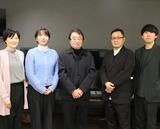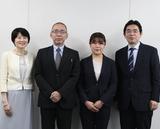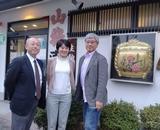March 2020
Working with International Human Resources: Advice from a Leading Intercultural Management Facilitator
Let's Try It Out!
Ohsato: Since we've gotten to learn about the Hofstede model, I'm hoping to put it to good use in the company. What I've noticed during in-house discussions is that people from France and Japan seem to share similar work processes, as do people from the US and China. So I don't feel like it's necessarily an east vs west thing. When it comes to French and Japanese people, they collect relevant data and discuss the process in great detail before coming to a conclusion. American and Chinese people, on the other hand, start with the conclusion and then work backward, so this creates a sense of discord when Japanese people are a part of the discussion.
Miyamori: Which dimension in the Hofstede model do you think is at the root of this issue?
Ohsato: Power distance? Or maybe individualism vs collectivism? I'm not sure.
Miyamori: I think it's uncertainty avoidance.
Ohsato: Oh really?
Miyamori: France and Japan are both countries that have a high tendency to avoid uncertainties, so the people need a lot of information to make decisions. They also don't want to be mistaken when they make counterarguments. So they choose to reach conclusions by considering a wide range of information. On the other hand, the US and China have low uncertainty avoidance scores, so they tend to think, "Let's try it out first, and if it doesn't work, we can look for other ways."
Ohsato: I see. That makes sense. It's also beneficial to know in a company like ours, which is made up of multinational members.
Miyamori: When working with a multinational team, it's very important to objectively discuss the sort of differences that exist between the members. But don't use expressions that make judgments based on nationality like, "Because you're French." Instead, use the Hofstede model as a neutral language and phrase your reasoning like, "I think you're trying to avoid uncertainties here, but I don't think we need help at this stage."
For example, let's say an employee from a Japanese company posted overseas is told by headquarters to collect extremely detailed data. The odds are a local employee (for example, an American person) will say, "Why do we have to collect such detailed data now?" In such a case, it is beneficial to be able to explain that Japanese people have a high tendency to avoid uncertainties, which is why they're asking for detailed data. Simply saying, "Because we're Japanese" isn't going to help American people understand.
Not Being Able to Understand Is the Starting Point
Ohsato: Some time ago in Japan, only a handful of people were working internationally, but now, there are a lot more international residents and visitors in Japan. There are also companies that are suddenly being transformed into foreign capital companies through mergers and acquisitions. Do you have any advice or messages to people who, all of a sudden, have had to work with people from different cultures?
Miyamori: I would first tell them that what they believe is right, may not, in fact, always be right. Next, differences in culture are not about being "good" or "bad"--they are just different. Thirdly, I think a lot depends on whether you can distance yourself from what is happening, including your emotions, and look at things objectively. To be able to do that, it's necessary to realize that if you were born in a different country, your mind's programming and your OS would be completely different. Our national culture is ingrained in us unconsciously, and we only first notice it when we're faced with a different culture. The Hofstede model is incredibly useful to understand these differences.
By the way, your struggles with intercultural management aren't just about communication in the company, is it? I feel like it's also part of the translation services you offer.
Ohsato: Oh yes, we see it all the time (laughs). We manage to deal with unfamiliar concepts by adding supplementary information during the translation process. For example, for the "masculinity vs femininity" dimension of the Hofstede model, we can help readers understand the essence of the concept better by explaining it as "quality of life vs desire for achievement." But a lot of the work we do is translating texts that are loaded with messages, so when a part of the sentence is rooted in culture, we struggle a lot with the translation.
Miyamori: I can imagine. It sounds incredibly difficult to accurately translate the core essence of sentences rooted in culture.
Ohsato: For example, let's say we needed to translate a message from the president of a company into English. The message quotes this Japanese proverb: 人間万事塞翁が馬 (ningen banji saiō ga uma). The proverb, in its literal sense, cautions against becoming easily elated or saddened because nobody knowns when happiness might turn to unhappiness. But when translating this, we have to be very careful that the English does not make the president look as though he is reluctant to making change.
Miyamori: Using language from the Hofstede model, we'd say Japanese people have a long-term orientation, so they don't fluctuate between hope and despair at every turn. I can clearly see the high level of masculinity attributed to Japanese people in the work you do at your company--that is to say, you are committed to achieving a high degree of perfection. Combined with the skills of your native-language translators who amplify the quality of translations by paying close attention to details, it's a level of competence found only at Arc Communications.
Ohsato: Thank you very much for closing with such a nice compliment. It was very interesting to learn about the Hofstede model today and I had a lot of fun. Thank you.
-------------------------
Contact point for Hofstede Insights Japan:
Hofstede Insights Japan
Need help with a translation or interpreting project? Feel free to contact us here.
Arc Communications
Feature Interview Index

















